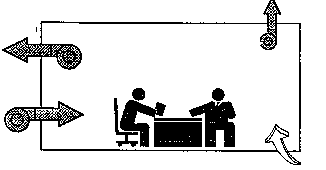|
FREQUENTLY ASKED QUESTIONS ABOUT HVAC |
|
Q. What are the most important elements of an A. There are four elements:
Q. What are "sealed ducts"? A. Ducts are tubes that make up a system to distribute heated or
cooled air to various rooms throughout a house. Sealed ducts have appropriately
installed joints and connections to minimize leakage of conditioned air. Air
leakage cannot be seen by the naked eye, therefore, diagnostic testing verifies
leakage and, by using complying tapes, mastics and mechanical fasteners or
aerosol sealant, leaks can be closed. Q. What is a "Duct Blaster®"?
A. A Duct Blaster® is a tool used to test the air leakage
rate of forced air duct systems. The equipment and appurtenances consist of a
calibrated fan, pressure tape to temporarily seal all the registers and grilles,
flexible duct to fasten the system to the central return or the air handler
cabinet of the duct system; and a digital monometer to measure fan flow and duct
pressure. Q. Do all houses have to have their duct systems sealed? A. Not necessarily. It depends on the compliance approach. Under the
Title 24 Prescriptive Compliance Method ducts must be sealed in all climate
zones. Under the Performance Compliance Method, the builder may make credit by
"trading-off" between the envelope, water heating and space
conditioning, but will probably find that duct sealing is the most
cost-effective measure. Q. Can I still put an HVAC forced air unit on a platform in the
garage? A. Yes. The return plenum that is normally located under the platform
must contain either a duct to the HVAC unit or be constructed of sealed sheet
metal or ductboard, not the commonly used sheetrock or drywall. Q. What kind of duct tape can I
use? A. You must use a UL 181 approved tape or sealant. Duct tape, which
is a cloth-backed tape with rubber adhesive is not permitted in the new Title 24
unless it is used with mastic and a draw band. Q. What are the new AB970 mandatory requirements for duct systems? A. The requirements under AB970 include:
In addition, when using the Prescriptive Compliance Approach, every
custom home and every seventh production home must be tested by a HERS rater. In
many cooling load zones, a thermostatic expansion valve (TXV) is required to
meter the correct amount of refrigerant in a system. Q. What is a "HERS" rater? A. A HERS rater is an energy expert certified by the California
Energy Commission (CEC) to rate homes in California according to the Home Energy
Rating System (HERS). These services include field verification and diagnostic
testing to differentiate energy efficiency levels among homes tested for duct
efficiency and envelope leakage for compliance with current building efficiency
standards. You can locate a HERS rater at www.cheers.org. Q. What do I have to do to be a HERS rater? A. To become a HERS rater, you must take a certification exam and
become certified by CHEERS. To do this you can take a training program through
CHEERS that provides technical instruction on the rating procedures and
background on residential construction and home heating and cooling equipment. Q. What is CHEERS? A. The California Home Energy Efficiency Rating System or CHEERS, is
a non-profit educational organization that trains and provides services to HERS
raters. CHEERS has been approved by the California Energy Commission as a
"Provider" for HERS. Q. Do I need to seal the ducts in multi-family housing? A. Yes, if the Prescriptive Compliance Method is used, the ducts must
be sealed according to the minimum requirements described above. Open-ended fan
coils may not be used in a sheet rock plenum unless the plenum is lined with
sealed ductboard or sheet metal. See Chapter 4 of the California Energy
Commission's Residential Manual for details on duct testing and sealing. |

